Trip Report – 30.12.2012 – 6.1.2013: Arthur’s Pass National Park Summer Camp
We thank Chris Moore, trip leader, Sheelagh Leary creator of the splendid menu, and Rodney Lewington for managing the accounts. We are most grateful to DOC staff and Arthur’s Pass Wildlife Trust for their memorable programme of evening talks, and to the Fire Service volunteers who pumped scores of cubic metres of storm-water from around our Outdoor Recreation Centre, during a torrential downpour.
In addition, we thank Chris Stewart (DOC), Michael McSweeney, Ray and Maree Goldring, and Danny Kember (DOC), for their help with making this trip a success.
Day 1 – 30/12/12: Arthur’s Pass Walking Track
Chris Stewart (DOC), aided by Hamish and his children, led us up the track, from the village, to beautifully restored Jack’s Hut. This outing was part of DOC’s summer programme. The upgraded track is a good example of the efforts that DOC makes to encourage people to study and enjoy indigenous ecosystems, such as this high-altitude forest. We saw
Pseudopanax linearis,
P. colensoi var.
ternatus, and numerous other species not found in the North Island.
Later that day, some of us botanised along O’Malley’s Track, on the true right side of the Waimakariri River. We saw
Peraxilla tetrapetala, in flower,
Hoheria glabrata,
Lagenifera pumila and
Rubus schmidelioides, under mountain beech and manuka.
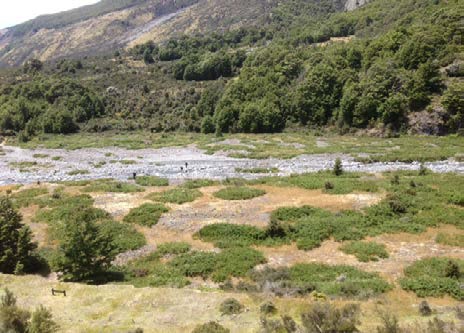 |
| A view looking east across the Broad Stream valley to the Moa Forest. Photo: Richard Herbert. |
Chris Horne
Day 2 – 31.12.12: Arthur’s Pass Wilderness Lodge and Broad Stream
The lodge and farm are 16 km east of Arthur’s Pass township. Michael McSweeney, a trained ecologist, talked to us about the property, and then guided us across Broad Stream river flats and the terraces beyond.
The lodge was established in 1996 by Michael’s parents, Gerry McSweeney and Anne Saunders, in partnership with the extended McSweeney family, to share a very special part of the South Island with visitors, and show how careful ecotourism can help to protect nature and provide rural communities with alternatives to destructive industries such as native forest logging. Gerry has also been greatly involved with Forest and Bird, and the Nature Heritage Fund, and at the 2010 NZ Plant Conservation Network conference, presented a paper about the indigenous vegetation on the property.
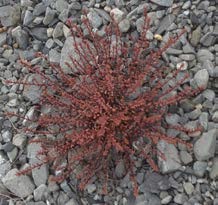 |
| Epilobium melanocaulon on Broad Stream river flats. Photo: Richard Herbert. |
Set on a 6000-acre merino sheep station, which includes the Cora Lynn Pastoral Lease block, Wilderness Lodge Arthur’s Pass demonstrates that conservation, well-managed farming, and tourism can be a winning combination. Half of the farm has been reserved, fenced and retired from grazing, after being in pasture for 150 years. Introduced pests and weeds have been controlled, and rare plants established. 1000 acres have been under possum and rat control with brodifacoum for the past 16 years, leading to a rapidly regenerating manuka and beech forest, locally called “Moa Forest”.
A major battle exists with the spread of wilding pines, mostly Douglas fir, from the neighbouring Craigieburn Conservation Park. Helped by conservation volunteers, they remove 3000 wilding pines from the property every six months.
On the other half of the property, a flock of super-fine merino sheep are run to supply wool for the fashion industry.
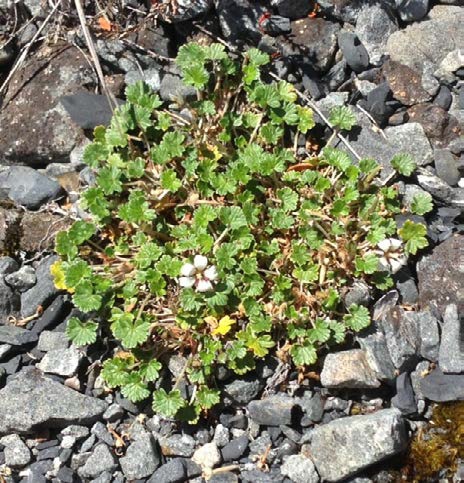 |
| Geranium sessiliflorum on Broad Stream river flats. Photo: Richard Herbert. |
Finds during our excursion on the braided bed of Broad Stream included:
Epilobium melanocaulon,
Helichrysum depressum,
Elymus solandri / blue wheat grass,
Geranium sessiliflorum, the thorny
Discaria toumatou / matagouri (wild irishman),
Coriaria sarmentosa,
C. plumosa / mountain tutu,
Vittadinia australis in flower, and
Wahlenbergia / harebell. Mistletoes seen included
Peraxilla tetrapetala / red mistletoe, and
Alepis flavida / yellow mistletoe, both in flower.
We searched the gravels for a grasshopper species, which Michael thinks may be endemic to this valley – it is rather similar to the robust grasshopper.
We followed a short section of the McKay Moa Forest Walk on the true right of the valley of Broad Stream, a true right tributary of the Waimakariri River. Among the plants we saw were
Aristotelia fruticosa / mountain wineberry,
Pittosporum divaricatum,
Polystichum vestitum / prickly shield fern,
Coprosma spathulata,
Clematis forsteri,
Helichrysum dimorphum / a climbing daisy,
Muehlenbeckia axillaris,
Helichrysum intermedium, in flower, perched on a ledge, masses of white manuka flowers and the invasive
Dryopteris filix mas / male fern.
Reference: Cora Lynn Station Crown Pastoral Land Tenure Review – Conservation Resources Report -
www.linz.govt.nz/crown-property/pastoral-land-tenure-review/status-of-pastoral-land/cora-lynn.
Richard and Margaret Herbert
Day 2, 31.12.12. McCaskill Scenic Reserve, Castle Hill
Named after Lance McCaskill, this was the first reserve in Aotearoa / NZ created to protect a single species,
Ranunculus paucifolius, commonly known as the Castle Hill buttercup. In 1948, this 6.2-ha area amongst the limestone outcrops was declared a reserve. It was found here by John Enys, the then run-holder, a keen naturalist.
The ranunculus grew among the outcrops, in a hollow of limestone sand and debris, originally scattered amongst hard tussock,
Festuca novae-zelandiae, which is now being replanted.
Lance McCaskill describes this plant: “Plant has marked xerophytic characters. Grows in limestone debris. Has deciduous leaves, radical, on stiff petioles, 3-7 cm and up to 6 cm in diameter. Three lobes with lobes overlapping and the margins are finely toothed or crenulate. They are greyish-green to ashen-purple in colour, somewhat fleshy and with some brown epidermal pits”.
The ranunculus and other species there, e.g.
Lepidium solandri, have strongly purple foliage due to anthocynans which is a response to high UV levels on the open limestone debris.
And he says:
“In 1948 the Lands and Survey Department fortunately decided to learn about this delightful plant, to work for the deferment of its euthanasia and to use it to assist the public, particularly young people, in finding out what conservation really means.”
The prime mover towards the preservation of the buttercup was Walter Boa Brockie (1897-1972). While working at Christchurch Botanical Gardens he developed an interest in native plants and made a special study of
Ranunculus paucifolius. He confirmed that excluding stock made the plants much larger. He was awarded the Loder Cup in 1945.
When he moved to Otari Native Botanic Garden, he asked Lance McCaskill to take over, and despite the war, McCaskill obtained the unobtainable, fencing wire and silver pine posts. With the help of student labour he erected a fence in 1948. At the time only 32 plants were found.
The reserve was gazetted in 1954. Access by the public was only with written permission of the Commissioner of Crown Lands. By 1958 145 plants existed. In 1961 each plant was surrounded by pieces of limestone rock to mark its position, and prevent damage by tramping. Some circles were still extant in 2012.
In 1977, to reduce the desire of the public to enter the unsupervised reserve, a small area adjoining the fence was planted with
Ranunculus paucifolius and other special plants of the area. Since the public found out about the rarity of these special plants, they have all been looted from the enclosure, despite the fact that the ranunculus is a Nationally Critical endemic, difficult to cultivate and should not be removed from the wild.
The more we looked, the more we found in this bare hollow. There were many low-growing plants, about 20 cm across and now setting seed, of Castle Hill forget-me-not,
Myosotis colensoi. In the slight shade provided by the huge boulders grew
Clematis forsteri var
australis,
Carmichaelia australis,
Coprosma petrei,
Aristotelia fructicosa and some ferns, e.g.
Anogramma leptophylla,
Asplenium lyallii and
Cheilanthes sieberi. In the open we saw
Pimelea prostrata, duly lying prostrate, some with trunks 15 mm in diameter, and
Senecio lautus var.
lautus (S. “Titahi Bay”) flowering with heads just above ground level up to 60 mm high.
We saw a Southern Alps gecko (
Woodworthia sp.), found on the east side of the Alps, and the bush giant dragonfly – kapokapowai -
Uropetala egrovia.
The most widespread introduced plants we saw were three species of hawkweed,
Hieracium spp., and oxeye daisy
Leucanthemum vulgare.
Danny Kember, DOC Rangiora, has been managing this reserve for only three months. He intends to remove the weeds, especially
Agrostis capillarisr browntop, whose roots compete with the rare plants. The original cover of stunted totara has long gone. Attempts to replant it have failed in the extreme conditions this area experiences.
It was salutary to note that because volunteers are used to weed around the
Ranunculus paucifolius, and can only identify their target plant, many of the other rare native treasures are pulled out in ignorance. With DOC planning to do much more of its work using volunteers, the situation will only be repeated nationwide.
Reference: The Castle Hill Buttercup (
Ranunculus paucifolius). A Story of Preservation. L W McCaskill. Tussock Grasslands and Mountain Lands Institute, Lincoln College, Canterbury, NZ. Special Publication no. 25.
Julia Stace
Day 3 – 1.1.13: Bealey Spur track
It was suggested that we should not say too much about the weather in trip reports, but how could you not, when the weather, together with the good humour of our group, were the main constants so far, five days into our ten-day camp.
Travelling east we had found better weather, so it was an easy decision to again go east this day to walk the Bealey Spur track. We climbed past holiday cottages, then entered patches of mountain beech and second-growth forest with wonderful clumps of scarlet mistletoe (
Peraxilla tetrapetala), often at eye level. A blood-red carpet had formed under one much photographed plant. Orchids were prominent, including
Gastrodia cunninghamii,
Pterostylis sp.,
Thelymitra sp.,
Prasophyllum colensoi,
Nematoceras trilobum,
Stegostyla lyallii and
Aprostylis bifolia. The track climbed steadily with a precipitous gorge on one side, before the ridge broadened with patches of beech forest and open red tussock clearings alternating. Skiffs of rain, with patches of sunlight, made for pleasant walking conditions. We had good views into the Waimakariri valley below, and saw persistent rain filling the heads of all valleys to the west.
The beech patches continued on and on and on, but most of the 25 who braved the weather reached the small, six-bunk hut on the edge of another beech patch. Here four young people in residence had a fire going and a welcome brew was possible. A strong wind made the return trip across the open tussock and wetland areas uncomfortable until we reached the forest lower down. Highlights of this trip were the views, the orchids and mistletoes, and the interesting plants in the wetlands that included patches of bladderwort (
Utricularia dichtoma), the comb sedges (
Oreobolus pectinatus and
O. strictus),
Gleichenia dicarpa,
Empodisma minus,
Drosera arcturi,
Lepidothamnus laxifolius,
Mazus radicans,
Gonocarpus micranthus,
Microseris scapigera, and
Celmisia alpina agg. Out in the tussockland we found
Hebe canterburiensis,
H. odora,
H. subaplina,
H. pauciramosa,
Dracophyllum kirkii,
D. rosmarinifolium,
Coprosma cheesemanii,
Pimelea oreophylla var.
oreophylla, and a hybrid daisy
Celmisia discolor x
C. duretzii.
Back in the forest we heard parakeets, a distant kea, riroriro, brown creeper and chaffinch. We looked at the several forms of
Raukaua simplex. We puzzled over the various coprosmas before deciding that
Coprosma propinqua,
C. dumosa,
C. microcarpa,
C. linariifolia and
C. pseudocuneata were all present. Altogether a successful day.
Neill Simpson
Day 4 – 2.1.13 Devil’s Punchbowl Falls
The day was a pluvial paradise, with over 400 mm of rain turning the Bealey River into a boulder-rolling, angry torrent. The foot-bridge over the river juddered as five bold souls, hermetically sealed in winter woollies and wet-weather gear, crossed it en route to an unforgettable spectacle – the falls rendered almost invisible by the gale of spray forced forth from the foot of the falls by the massive volume of water roaring out of the steep catchment.
This was the day that the Fire Brigade volunteers came with three high-capacity pumps to stem the flow of flood water rising steadily to surround our base.
Day 5 – 3.1.13 Craigieburn Forest Park – weed clearance
A kereru appeared on the veranda of the Outdoor Centre holding a miro twig in its beak – it had stopped raining. We headed east to Craigieburn Forest Park and spent the morning pulling out wildling Douglas fir growing along the side of the road. It is doubtful that we made much of an impact over the morning. As is the case in other parts of the country, wildling conifers have become a major problem. Douglas fir planted on the Cragieburn Range is spreading out over Castle Hill Basin. The seedlings of this species germinate anywhere; in bogs, in shade under beech, and in the tussock grassland. Douglas fir grows rapidly and overtops the native vegetation replacing it entirely.
David Lyttle
We received this letter from Ray and Maree Goldring:
Thanks for the work you did for Waimakariri Ecological and Landscape Restoration Alliance, WELRA. It was a great effort and well appreciated. We have commenced the spraying now - so next time a member of your group goes through they will see more dead trees around the area.
Thanks for the species data – we’ll add them to our database for the Canterbury Environmental Trust which runs the Environment Education Centre further up the road from where you parked your vehicles that day.
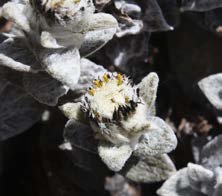 |
| Haastia pulvinaris. Photo: Pascale Michel. |
Day 6 – 4.1.13 Temple Basin Ski-field
We started at the car park at 9.30 a.m. on a hot sunny day to be welcomed by two friendly kea. A 4WD road runs for c. 1 km up the mountain. Along the side,
Coprosma serrulata and
Olearia arborescens (common tree daisy) were flowering, and the pink male cones on
Podocarpus nivalis (snow totara) shrubs were obvious. Amongst shrubs and tussock grasses, the delicate flowers of
Stegostyla lyallii (orchids) stood out. Where the terrain steepened, the gravel road changed to a narrow, winding track up to the ski field huts. From there, the first plants of
Ranunculus lyallii (Mount Cook lilies) were found, and were in full blossom from the ski field to the base of the upper scree slopes. Fields of white celmisia (mountain daisy) flowers e.g.
Celmisia sessiliflora,
C. armstrongii,
C. laricifolia,
C. verbacifolia,
C. vereteii, sometimes dotted with pale yellow flowers of hybrid
Dolichoglottis scorzoneroides x
C. lyallii were spread along the banks of the many creeks.
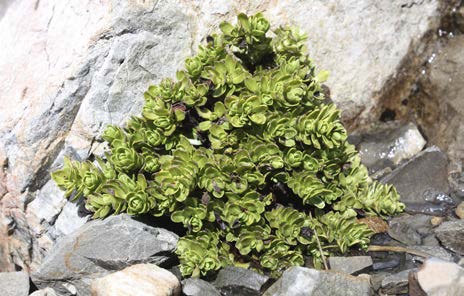 |
| Hebe macrocalyx var. macrocalyx. Photo: Pascale Michel. |
Beyond the huts we crossed the bridge over the true left fork of the stream, while most people stayed on the true right and proceeded to the screes at the head of the true right branch. We walked through a swamp where
Donatia novae-zelandia was flowering, and
Coprosma perpusilla was in berry. Also abundant and not flowering were
Drosera arcturi (sundew) and
Astelia linearis. Climbing the screes and dry creeks on the eastern slopes of the true left branch, we saw
Leucogenes grandiceps (South Island edelweiss),
Viola cunninghamii (mountain violet) and
Leptinella pyrethrifolia (button daisy). We finally reached the upper scree slopes above the waterfalls and below the ridge top. A field of big boulders hosted little plant life, with the exception of secretive colonies of Hebe
macrocalyx var.
macrocalyx and
Haastia sinclairii tucked between rocks where the screes were finer and had some surface soil content. At 5.30 p.m., hot and tired after a fantastic day, we turned around and headed home to another great dinner.
Owen Spearpoint and Pascale Michel
Day 7 – 5.1.13 Cockayne Nature Walk
We admired the engineering of the Otira Viaduct, and the old rata in full bloom. It was a lovely fine and sunny day, but there were signs of the 500 mm of rain we had had earlier in the week. When we parked at Kelly’s Creek, the water was still murky, and the vast quantity of shingle brought down by the flooding creek had piled up to within half a metre of the bridge deck. A bulldozer was working away, but looked very small for such a big job.
The Cockayne Nature Walk is in an area of old West Coast podocarp forest, with large kamahi, totara, rimu, fuchsia, drippy lichens on the trees, and cushioning moss on the track.
We had yet another discussion about
Blechnum montanum,
B. procerum, and
B. vulcanicum, and basal pinnae reduced / not reduced, swept back / cut off straight. We enjoyed seeing larger numbers of healthy
B. nigrum than we see around Wellington; and the
Leptopteris superba were indeed superb.
We noticed that the
Coprosma foetidissima seemed to have a different leaf form to our North Island one. NZPCN says ‘Lamina membranaceous to subcoriacous, obovate to oblong to broadly ovate, obtuse, apiculate to mucronulate, 30-50 x 14-20 mm’, so that would seem to cover a bit of variation.
We puzzled over some heavily browsed tips on the
carmichaelia by the track, especially as the
griselinia and pate had not been touched.
Someone spotted a 4 m tall pokaka (
Elaeocarpus hookerianus), still in its juvenile form, and showing no signs yet of maturing. And we admired a giant
Polystichum vestitum, the size of a small car.
Day 7 – 5.1.13 Otira Valley
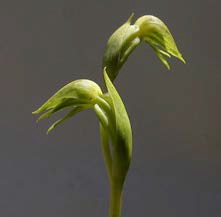 |
| Waireia stenopetala. Photo: Sunita Singh. |
The Otira Valley was a pleasant contrast of open, sunny, semi- to sub-alpine vegetation, where we had a tea-break among the multi-coloured patchwork of shrub, mat, and ground-hugging conifers. We decided we needed to do more work on these. Another topic for questioning was why some daisy-like plants are called
Brachyglottis, and some
Olearia?
We sorted out
Celmisia armstrongii (orange-brown midrib on upper leaf surface) and
C. lyallii (strongly striated on the under surface of the leaf). We admired a flowering
Waireia stenopetala, and our prone posture attracted a group of curious tourists, who politely photographed the subdued little orchid. We enjoyed seeing the tiny but bright yellow
Euphrasia cockayneana, named for Leonard Cockayne.
After a couple of hours, we got to the bridge, which was spectacularly sited, spanning two handy house-sized rocks – the only possible bridge position for kilometres. Above the bridge (where the notice said ‘Mountaineering skills required’!), more alpines were seen, including a large-headed leptinella in flower, some ancient, contorted
Melicytus alpinus, and ‘a field of flowering
Ranunculus lyallii’.
We met and chatted with a Post Doc student from Hokkaido University, Japan, who was on her fifth NZ visit, studying the pollination of NZ alpine plants. Her special areas of study were The Remarkables, Old Man Range, Mt Hutt, and the Otira Valley. She was given a plant list, and e-mail addresses were swopped.
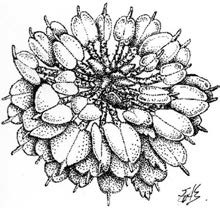 |
| Notothlaspi rosulatum in seed. Illustration: Eleanor Burton. |
The three splinter groups enjoyed their alternative trips to:
•
Broken River –
Anisotome filifolia, flowering
Notothlaspi rosulatum,
Leptinella dendyi.
•
Carrol Hut –
Dracophyllum 4m high, lacebark, and swimming with tadpoles,
•
Bealey Spur – excessive heat, marvellous views.
Jill and Ian Goodwin
Day 8 – 6.1.13 Margaret Tarn/Bealey Chasm Dobson Walk
Day 9 – 7.1.13 Broken River Craigieburn
Arthur’s Pass Lichen Report
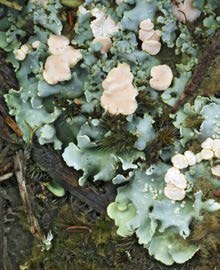 |
| Icmadophila splachnirima. Photo: Allison Knight. |
Arthur’s Pass and the surrounding areas are exceptionally rich in lichens. This reflects the wide range of habitats; from dripping beech forests, up to subalpine scrub, tussock and exposed alpine ground and rock; from sunny, rocky riverbeds to the exposed limestone bluffs at arid Castle Hill. My list covers a tiny fraction of the many lichen species (probably more than all the plant species) in these areas. It is not very representative, as we tended to ignore most of the obvious common lichens, apart from a few for the display table, and concentrate on the unusual and on those of interest for two PhD students doing valuable research. Lars Ludwig is studying
Icmadophila splachnirima and other members of the family
Icmadophilaceae, which including
Thamnolia,
Siphula and
Dibaeis, while
Arash Rafat is extending our knowledge of the genus
Usnea/.
A quick examination of pale clumps of fruticose lichens yielded seventeen species in six genera. The beautiful, lacy-white, coral lichen,
Cladia retipora, often occurred on damp, peaty ground, along with the creamier, more finely branched,
Cladonia confusa, the greener
Cladia sullivanii (sunburned brown in exposed places), and the ubiquitous, spiky
Cladia aggregata. Various creamy
Usnea species formed conspicuous clumps on trunks and branches in forest and scrub, and the long, dangling old man’s beard,
U. articulata added an elfin ambience to the mist forest. On the forest floor and mossy trunks grew finely branched, white
Leifidium tenerum, with its stalked, powdery black fruit. The straggly, thicker branched and very common
Stereocaulon ramulosum is more characteristic of disturbed ground beside tracks, and can be distinguished by its brown apothecia (fruit) and the grey nodules of cyanobacteria protruding from its stalks.
Siphula species generally have short, flattened branches and are unusual in forming root-like structures embedded in the ground. They often form eye-catching white swards in alpine or open subalpine areas. Thanks to Alf Webb and David Lyttle for spotting
Siphula decumbens on Bealey Spur.
Diverse pale crusts abounded. Two common ones spreading over disturbed banks were
Baeomyces heteromorphus, with flesh-coloured to red-brown apothecia on short stalks, and the somewhat similar
Dibaeis arcuata, with candy-floss pink apothecia on chalky white stalks.
Lecanora epibryon, with very dark-brown apothecia, is common on dead tussock bases, while black-fruited
Tephromela atra is found on rock or bark; both are well illustrated by Janet
Ledingham in Alan Mark’s excellent new book, Above the Treeline. Among the rough grey-white crusts on the short piece of fallen branch brought back for the display table there were three species of
Pertusaria. Two were common, but I was excited to find that the third had chemistry that matched an un-described species found on the Boyd Creek trip. I managed to extract some spores under the microscope and sent a piece to Jack Elix in Australia for more advanced chemistry. He explained that a subsidiary chemical made by the lichen was confounding the tests, and that both collections are actually
Pertusaria scutellifera. It is good to have that three-year-old mystery finally solved. I was also pleased to find pale
Diploschistes gysaceus for the first time, under a dry limestone overhang at Castle Hill.
Foliose lichens tend to be the biggest and most obvious lichens.
Pseudocyphellaria and
Sticta, with their loose, leaf-like lobes are very characteristic of NZ rainforest and there were surely many more species than listed here.
Menegazzia species, with their curious, hollow, inflated lobes studded with holes, are abundant in the local forests. A new species,
Menegazzia gallowayi was recently described from Cragieburn Forest. I was sorry not to see this, but pleased to get a photo of the widespread
Menegazzia pertransita, common on
Nothofagus trunks at Wilderness Lodge, and also to see Alf’s find of the less common
Peltigera ulcerata nestling on the ground between stones on the old bed of Broad Stream.
Like us, lichens can manufacture melanin compounds as sunscreen, as demonstrated by the darkened lobes of
Xanthoparmelia malcolmii, mingled with the equally dark crustose
Placopsis perrugosa spreading over the less disturbed rocks at Broad Stream. The latter can be distinguished by the flattened, pinkish to grey nodules of cyanbacteria (cephlodia), which are characteristic of
Placopsis.
Keenly sought after for Lars’s research, but not spotted, was the threatened foliose lichen
Icmadophila splachnirima, (also illustrated in
Above the Treeline.)
By far the most exciting find of the trip was
Siphula fastigiata, bearing tiny, pink, gall-like nodules, reminiscent of those mentioned in
Flora of NZ Lichens. Not long before, during the John Child Bryophyte and Lichen Workshop on Stewart Island in November 2012, Lars found apparently fertile specimens of the closely related
Siphula decumbens. Anatomical characters of the fruits fit well into its family
Icmadophilaceae, but as the genus
Siphula has always been considered to be strictly sterile, this could be a world-first discovery! Based on DNA sequence analysis, he has since established that these really are
Siphula’s fruiting bodies. We have since found them in four locations on two
Siphula species, which, however, might represent only one species comprising two chemotypes, as they are genetically almost identical.
Allison Knight
Participants : Bev Abbott, Margaret Aitken, Beth Andrews, Owen Calder, Donna & John Christeller, Barbara Clark, Rae Collins, Gavin Dench, Brett de Vore, Raewyn Empson, Dale Every, Julian Fitter, Ken Fraser, Kathy Gibbings, Ian & Jill Goodwin, Margaret & Richard Herbert, Chris Horne, Brenda Johnston, Allison Knight, Sheelagh Leary, Rodney Lewington, David Lyttle, Pascale Michel, Chris Moore, Syd Moore, Emil Schmieg, Darea Sherratt, Barbara & Neill Simpson, Sunita Singh, Val Smith, Owen Spearpoint, Julia Stace, Alf Webb.

 Site Index
Site Index







 Site Index
Site Index





